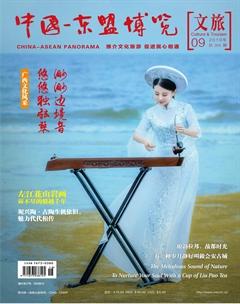The melodious sound of nature
Tingting



When you look at the single-stringed instrument (“Duxianqin” in Chinese), the first thing you probably notice will be its string. How can such beautiful melodies come from just one string? You can see that a performer plucks the string with his right hand while removing the lower side of the same hand from one of the seven notes of natural harmonics on the string. Simultaneously, the performer needs to control the pitch of the sound with his left hand by moving the spout to create less or more tension on the string. The result is a unique sound that cannot be duplicated by any other musical instrument in the world.
Jing's culture
A cornerstone of Jing's culture
Jing people are mostly living in the Shanxi Island, Wutou Island and Wanwei Island of Dongxing, Fangchenggang City, Guangxi Zhuang Autonomous Region. People called them the Yue in the old days because they are from the Yue people, the majority ethnic group in Vietnam. It was said that the ancestors of the Jing emigrated from Haiphong City, Vietnam in the early 16th century. In 1958, they have officially been named as the Jing.
Jing people like antiphonal songs which are melodious and lyrical.There are various kinds of ballads, some of which are about the sea. Besides, Jing people have volumes of myths inherited from their ancestors, which are mostly about the marine gods. Their traditional instruments include the two-stringed instrument, flute, drum, gong and the single-stringed instrument, an ancient folk vibrating-string instrument of the ethnic minority. During the past centuries, some elements of Jing's culture have blended with those of other ethnic groups, such as the Han and the Zhuang. However, Jing people's single-stringed instrument still retains its unique characteristics.
The single-stringed instrument, also known as the single-stringed fiddle, is an artistic treasure rooted in Jing's culture. As its name implies, there is only one string. The single-stringed instrument is said to date back to the 8th century and it has long been popular in Southeast Asian countries such as Vietnam and Myanmar.
At present, the skills of playing the ancient instrument have been inherited largely thanks to the efforts of Su Chunfa, a dedicated man in Dongxing, Guangxi. For Su Chunfa, his students passion for the single-stringed instrument assures him that this traditional art wont be lost to the world. “Amazingly, one string can produce such a wide range of melodies,” said Su. The 64-year-old man seemingly loses himself in the music as he plays the instrument.
The single-stringed instrument is an indispensable part of life for the Jing people who largely live in coastal areas and earn a living by fishing. They often play music and sing during their spare time after returning from the sea, or as part of major celebrations, such as weddings. Generally, the instrument is common for groups of its players to play as an accompanying instrument during the large-scale and small-scale Chinese festivals, such as the Changha Festival of the Jing ethnic group, but it is also good for solo pieces. Changha (“singing” in Chinese) is celebrated at different times by different communities, highlighting singing, feasting and staging performances designed to entertain spirits. The festival often features the beating of drums and music made from the single-stringed instrument.
Since 2010, the single-stringed instrument has been recognized by the Chinese government as an intangible cultural heritage. Now it is a symbol of Jing's culture. Also, the cultural significance of the single-stringed instrument for many ethnic groups is commonly accepted and enjoyed within China.
The single-stringed instrument
Captivating sounds
from one string
The single-stringed instrument is 80 cm long and shaped like a rectangular box. Sometimes the body of the instrument is made of a large tube of bamboo rather than wood. There are five main components, including the soundboard, spout, gourd, string and tuning peg. The spout is a piece of bamboo or a buffalo horn that is square-framed at the root and gradually bent at the top. The gourd is made of half a slender-necked gourd, which covers the spout at the point where the string is hung. The gourd contributes to increasing the loudness of sound from the instrument. The string runs along the body of the instrument. The tuning peg is made of bamboo or wood, which is located inside the frame of the bottom of the soundboard.
The single-stringed instrument is renowned for its simple structure and charming timbre. Its playing method is distinct and can deliver wonderful, captivating sounds from any notes. When playing this instrument, the player holds the instrument in their left hand and plucks the string with a tiny piece of bamboo in their right hand. The pinky of the right hand gently taps the string at one of seven commonly used notes while the other fingers pluck the string using a long plectrum. It can play four basic notes and decorating notes. Depending on the direction that the rod is turned, either toward or away from the player, it will bend the pitch of the string to higher or lower notes.
For most people, the single-stringed instrument seems exotic, but the sound it generates is incredibly attractive to listeners. The vibration of this single string can depict such a scene as a hundred birds paying homage to the sun. The gentle and lingering tones can symbolize fish swimming in the blue sea, with a vast cloudless sky above them. Sometimes, it also denotes the sounds of the ocean lapping against the bank.
This traditional instrument and music have been handed down for generations. Nowadays, Jing people are highly aware of the importance of preserving their cultural heritage, both tangible and intangible. Many Jing villagers can play the single-stringed instrument. Children learn how to play it from their parents or grandparents. With the instrument's smooth, sweet and captivating sound, Jing people's villages will be always filled with harmonic music.

